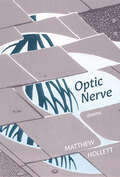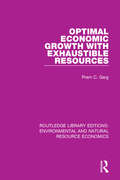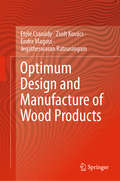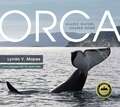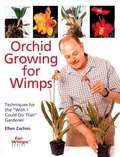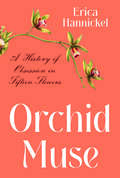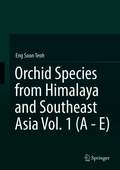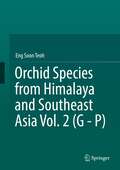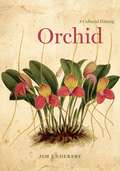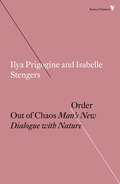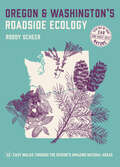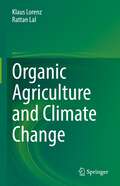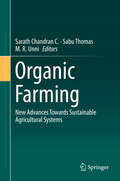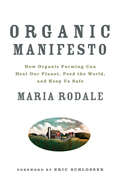- Table View
- List View
Optic Nerve
by Matthew HollettShortlisted 2024 JM Abraham Award for PoetryPoems using fervent whimsy and wordplay to examine photography and seeing. Peering inside eyeballs, pondering the paradox of absent stars, and meditating on street scenes by André Kertész, these poems squint sidelong at our ways of seeing the world. Through playful poems about photography and visual perception, Hollett dissects auroras and quarks, atmospheric phenomena, potatoes, bomb craters and peat bog cadavers. This darkly comic collection is shadowed by entoptic paparazzi, haunted by peripheral visions. Born of attentive walking and looking, of footsteps and snapshots, it bears witness to art history and alluvial light, portable keyholes, the pandemic, climate change, and the sheer strangeness of seeing everyday things with ecstatic eyes.
Optimal Economic Growth with Exhaustible Resources (Routledge Library Editions: Environmental and Natural Resource Economics)
by Prem C. GargOriginally published in 1979. For decades conservationists have argued that increasing population will eventually out-strip the limited natural resources of the earth. Economists have responded by saying that any resource scarcity will be forestalled by changes in tastes and technology, induced by the appropriate price signals. This study is an attempt to develop a theoretical framework for analysing some of the issues related to this debate. Using an optimal growth theory framework, the author analyses the problem of optimally allocating a finite stock of the resource over time. In the process the author points out the crucial parameters and value judgments relevant to the various issues. This title will be of interest to students of environmental economics.
Optimal Mobile Sensing and Actuation Policies in Cyber-physical Systems
by Yangquan Chen Christophe TricaudA successful cyber-physical system, a complex interweaving of hardware and software with some part of the physical environment, depends on proper identification of the, often pre-existing, physical element. A bespoke "cyber" part of the system may then be designed from scratch. Optimal Mobile Sensing and Actuation Strategies in Cyber-physical Systems focuses on distributed-parameter systems the dynamics of which can be modelled with partial differential equations. These are very challenging to observe, their states and inputs being distributed throughout a spatial domain. Consequently, systematic approaches to the optimization of sensor location have to be devised for parameter estimation. The text begins by reviewing the field of cyber-physical systems and introducing background notions of distributed parameter systems and optimal observation theory. New research problems are then defined within this framework. Two important problems considered are optimal mobile sensor trajectory planning and the accuracy effects and allocation of remote sensors. These are followed up with a solution to the problem of optimal robust estimation. Actuation policies are then introduced into the framework with the purpose of improving estimation and optimizing the trajectories of both sensors and actuators simultaneously. The large number of illustrations within the text will assist the reader to visualize the application of the methods proposed. A group of similar examples are used throughout the book to help the reader assimilate the material more easily. The monograph concentrates on the use of methods for which a cyber-physical-systems infrastructure is required. The methods are computationally heavy and require mobile sensors and actuators with communications abilities. Application examples cover fields from environmental science to national security so that readers are encouraged to link the ideas of cyber-physical systems with their own research.
Optimum Design and Manufacture of Wood Products
by Endre Magoss Etele Csanády Zsolt Kovács Jegatheswaran RatnasingamThis monograph presents state-of-the-art knowledge in wood manufacturing design with a special focus on the elaboration of functional relationships. The authors transfer and apply the method of functional relationships to challenges in wood manufacturing, and the book contains many worked examples which help the reader to better understand the presented method. The topical spectrum includes machining processes, energy consumption, surface quality, hardness and durability properties as well as aesthetical properties. The target audience primarily comprises research experts and practitioners in wood manufacturing, but the book may also be beneficial for graduate students alike.
Or Else My Lady Keeps the Key
by Kage BakerIt's 1672 in Port Royal, Jamaica. John James, London bricklayer's apprentice turned pirate, is returning from the sack of Panama with his share of the loot (a lousy 200 pieces of eight) and a resolve to go back to bricklaying, since piracy pays so badly. First, though, he has a duty: he must deliver a letter to a lady. The letter is from his dead comrade, Sir Thomas Blackstone, who was a court intriguer on a mission for Prince Rupert of the Rhine. The letter's recipient is Clarissa Waverly, Blackstone's mistress and accomplice. Before he went off to Panama, Blackstone hid four thousand pounds of the prince's money, unwilling to trust his lady friend not to make off with it in his absence. Dying of battle wounds, he wrote to let her know where he'd concealed the money.
Or Something Worse: Why We Need to Disrupt the Climate Transition
by Nicholas BeuretThe push for net zero has become a new arena for class conflict, where the powerful profit and the rest suffer. Nicholas Beuret's incisive critique and actionable strategies empower us to fight for a truly sustainable and equitable future.Or Something Worse exposes the bleak realities of the transition to a carbon-neutral economy. Greening the economy has become a one-sided war, as governments and businesses squeeze the living standards of ordinary people. We need to seize control of the transition in order to reshape it to equitable ends.Existing policies won&’t limit global heating to anything close to a safe level. Claims of sustainability disguise a zero-sum battle where the powerful profit and everyone else foots the bill. Green growth was supposed to bring increased wealth for all. Instead, work has been degraded, energy bills have soared, and the most basic necessities have become expensive and scarce.We need to disrupt green capitalism. Nicholas Beuret follows those already fighting back through &‘don&’t pay&’ campaigns, blockades of fossil-fuel infrastructure, and community counter-planning. He shows we have the tools not only to stop climate change but to build a fairer future.
Orca: Shared Waters, Shared Home
by Lynda MapesOrca whale J35, also known as "Tahlequah," gave birth in July of 2018 in the waters off British Columbia, but her calf died soon after, leading its mother to carry her for 17 days across 1000 miles before finally releasing the calf and rejoining her pod. This extraordinary and caring behavior sparked not only worldwide sympathy, but also a revival of our awareness of the critical need to preserve orcas, the chinook salmon they feed on, and their habitat that together make up the core of Pacific Northwest identity. In Orca: Shared Waters, Shared Home journalist Lynda V. Mapes explores the natural history of the orca and the unique challenges for survival of the Southern Resident group that frequents Puget Sound. These whales are among the most urban in the world, a focus of researchers, tourists, and politicians alike. Once referred to as "blackfish" and still known as "killer whales," orcas were for generations regarded as vermin to be avoided or exterminated, then later were captured live for aquariums all over the world. With greater exposure, scientists realized how intelligent the mammal is and are learning about their matriarchal family groups, vocalizations, behavior, and different subspecies. Today only 74 Southern Resident whales are left, and they are threatened by habitat degradation, lack of chinook salmon (their primary food source), relentless growth, and climate change. Can we reverse the trend? This special project, co-published with the Pulitzer Prize winning Seattle Times newspaper, features stunning imagery by Times photographer Steve Ringman, as well as from partner organizations including The Whale Museum, NOAA, and Center for Whale Research.
Orcas Everywhere: The History and Mystery of Killer Whales (Orca Wild #1)
by Mark Leiren-YoungOrcas are found in every ocean on the planet. But can they survive their relationship with humans? Orcas Everywhere looks at how humans around the world (Indigenous and non-Indigenous alike) related to orcas in the past, how we relate to them now and what we can do to keep cetacean communities alive and thriving. The book deals with science, philosophy, environmentalism and ethics in a kid-friendly and accessible way. Writer, filmmaker and orca activist Mark Leiren-Young takes us back to when killer whales were considered monsters and examines how humans went from using orcas for target practice to nearly loving them to death. If you know a young person who loves Free Willy or Finding Nemo, they will fall in love with these whales.
Orchards
by Claire MassetWhether in blossom and laden with fruit, orchards are places of great beauty. Throughout history, they have played an important role in country, and also city, life, providing not just food and drink, but also a haven for wildlife and a setting for age-old customs and social gatherings. Some of Britain's surviving orchards are almost 600 years old. But when did orchards first appear? Why are there over 3,000 varieties of apple, so varied in colour, shape, texture and taste? What is wassailing and who did it? Why has England lost almost two-thirds of its orchards since 1950 - and what is being done about it today? This beautifully illustrated book reveals the engaging story and rich diversity of Britain's orchards and answers many intriguing questions along the way.
Orchid Growing for Wimps
by Ellen ZachosA superb primer on orchid culture. It uses a step-by-step approach and doesn't skimp on relating complete details. There's a chapter showing easy-to-grow orchids in all their glory, and there's also a chapter warning about 'difficult' orchids to avoid. This book takes you on a visit to 16 terrific varieties you can easily handle.
Orchid Muse: A History Of Obsession In Fifteen Flowers
by Erica HannickelOne of Literary Hub's Most Anticipated Books of 2022 A kaleidoscopic journey into the world of nature’s most tantalizing flower, and the lives it has inspired. The epitome of floral beauty, orchids have long fostered works of art, tales of adventure, and scientific discovery. Tenacious plant hunters have traversed continents to collect rare specimens; naturalists and shoguns have marveled at orchids’ seductive architecture; royalty and the smart set have adorned themselves with their allure. In Orchid Muse, historian and home grower Erica Hannickel gathers these bold tales of the orchid-smitten throughout history, while providing tips on cultivating the extraordinary flowers she features. Consider Empress Eugenie and Queen Victoria, the two most powerful women in nineteenth-century Europe, who shared a passion for Coelogyne cristata, with its cascading, fragrant white blooms. John Roebling, builder of the Brooklyn Bridge, cultivated thousands of orchids and introduced captivating hybrids. Edmond Albius, an enslaved youth on an island off the coast of Madagascar, was the first person to hand-pollinate Vanilla planifolia, leading to vanilla’s global boom. Artist Frida Kahlo was drawn to the lavender petals of Cattleya gigas and immortalized the flower’s wilting form in a harrowing self-portrait, while more recently Margaret Mee painted the orchids she discovered in the Amazon to advocate for their conservation. The story of orchidomania is one that spans the globe, transporting readers from the glories of the palace gardens of Chinese Empress Cixi to a seedy dime museum in Gilded Age New York’s Tenderloin, from hazardous jungles to the greenhouses and bookshelves of Victorian collectors. Lush and inviting, with radiant full-color illustrations throughout, Orchid Muse is the ultimate celebration of our enduring fascination with these beguiling flowers.
Orchid Species from Himalaya and Southeast Asia Vol. 1 (A - E)
by Eng Soon TeohA presentation of 491 popular orchid species with 13 varieties and 3 natural hybrids in 51 genera with names beginning with A to E carefully detailed with beautiful photographs and concise descriptions of the plants, their distribution and habitats by a well-known author and photographer. Each genus is assigned a separate chapter. Coverage of the most commonly cultivated Asian species including their varieties and cultivars (e.g. in Bulbophyllum 82 species; Coelogyne 37 species; Dendrobium 210 species) is exhaustive. The orchids are photographed from their best perspective as individual blooms or entire inflorescences. Many species are also shown growing in their natural habitat. Representative hybrids are included to illustrate how some species have contributed to show-worthiness of various genera, their adaptation to a wider climate range, and easy cultivation. This book is a pleasure to view; simultaneously, an easy reference for the identification of orchid species and it provides a guide on how best to grow them. Nowhere else will one find so many popular species beautifully illustrated in a single volume.Volume 1 is the first of a 3 Volume series that will showcase over 900 species plus varieties in 117 genera. A must for everyone fascinated by orchids or simply with a love for nature.
Orchid Species from Himalaya and Southeast Asia Vol. 2 (G - P)
by Eng Soon TeohA presentation of over 700 popular orchid species in 104 genera carefully detailed with beautiful photographs and concise descriptions of plants, their distribution and habitats by a well-known author and photographer. Each genus is assigned a separate chapter. Coverage of the most commonly cultivated Asian species including their varieties and cultivars (e.g. in Bulbophyllum 72 species; Coelogyne 33 species; Dendrobium 161 species; Paphiopedilum 58 species; Phalaenopsis 60 species; Vanda 44 species) is exhaustive. The orchids are photographed from their best perspective, individual blooms and entire inflorescence: additionally, many species are also shown growing in their natural habitat. Representative hybrids are included to illustrate how some species have contributed to show-worthiness of various genera, their adaptation to a wider climate range, and easy cultivation. This book is a pleasure to view; simultaneously, an easy reference for the identification of orchid species and it provides a guide on how best to grow them. Nowhere else will one find so many popular species beautifully illustrated in a single volume.A must for everyone fascinated by orchids or with a love for nature.
Orchid Species from Himalaya and Southeast Asia Vol. 3 (R - Z)
by Eng Soon TeohA presentation of over 700 popular orchid species in 104 genera carefully detailed with beautiful photographs and concise descriptions of plants, their distribution and habitats by a well-known author and photographer. Each genus is assigned a separate chapter. Coverage of the most commonly cultivated Asian species including their varieties and cultivars (e.g. in Bulbophyllum 72 species; Coelogyne 33 species; Dendrobium 161 species; Paphiopedilum 58 species; Phalaenopsis 60 species; Vanda 44 species) is exhaustive. The orchids are photographed from their best perspective, individual blooms and entire inflorescence: additionally, many species are also shown growing in their natural habitat. Representative hybrids are included to illustrate how some species have contributed to show-worthiness of various genera, their adaptation to a wider climate range, and easy cultivation. This book is a pleasure to view; simultaneously, an easy reference for the identification of orchid species and it provides a guide on how best to grow them. Nowhere else will one find so many popular species beautifully illustrated in a single volume.A must for everyone fascinated by orchids or with a love for nature.
Orchid: A Cultural History
by Jim EndersbyAt once delicate, exotic, and elegant, orchids are beloved for their singular, instantly recognizable beauty. Found in nearly every climate, the many species of orchid have carried symbolic weight in countless cultures over time. The ancient Greeks associated them with fertility and thought that parents who ingested orchid root tubers could control the sex of their child. During the Victorian era, orchids became deeply associated with romance and seduction. And in twentieth-century hard-boiled detective stories, they transformed into symbols of decadence, secrecy, and cunning. What is it about the orchid that has enthralled the imagination for so many centuries? And why do they still provoke so much wonder? Following the stories of orchids throughout history, Jim Endersby divides our attraction to them into four key themes: science, empire, sex, and death. When it comes to empire, for instance, orchids are a prime example of the exotic riches sought by Europeans as they shaped their plans for colonization. He also reveals how Charles Darwin's theory of evolution became intimately entangled with the story of the orchid as he investigated their methods of cross-pollination. As he shows, orchids--perhaps because of their extraordinarily diverse colors, shapes, and sizes--have also bloomed repeatedly in films, novels, plays, and poems, from Shakespeare to science fiction, from thrillers to elaborate modernist novels. Featuring many gorgeous illustrations from the collection of the Royal Botanic Gardens, Kew, Orchid: A Cultural History tells, for the first time, the extraordinary story of orchids and our prolific interest in them. It is an enchanting tale not only for gardeners and plant collectors, but anyone curious about the flower's obsessive hold on the imagination in history, cinema, literature, and more.
Orchids For Dummies
by National Gardening Association Steven A. FrowineBecome a plant parent to some of the most stunning flowering plants you’ve ever seen Orchids display more beautiful and exotic flowers than you’ll find on other flowering plants, but they do require some love and care to grow well. With help from Orchids For Dummies, anyone can be successful in growing and flowering these gorgeous and fragrant plants in their garden or home! This step-by-step guide shows you how to select orchids that will thrive in your own unique environment and how to water, fertilize, repot, and propagate them on your own. You’ll learn to decipher complicated orchid names (“phalaenopsis,” anyone?) and create spectacular displays. You’ll also discover: New information about updated plant and orchid classification systems so you can know what to buy at your local garden center or store Expanded info on moth orchids, one of the most popular varieties of the plant sold in the world today Updated instructions on which pesticides, fertilizers, and potting materials you should be using Perfect for amateur gardeners, orchid-lovers, and anyone interested in growing these exquisite flowers on their own, Orchids For Dummies will turn your thumb green in no time at all!
Order Out of Chaos
by Ilya Prigogine Isabelle StengersA pioneering book that shows how the two great themes of classic science, order and chaos, are being reconciled in a new and unexpected synthesis.Order Out of Chaos is a sweeping critique of the discordant landscape of modern scientific knowledge. In this landmark book, Nobel Laureate Ilya Prigogine and acclaimed philosopher Isabelle Stengers offer an exciting and accessible account of the philosophical implications of thermodynamics. Prigogine and Stengers bring contradictory philosophies of time and chance into a novel and ambitious synthesis. Since its first publication in France in 1978, this book has sparked debate among physicists, philosophers, literary critics and historians.
Ordering Life: Karl Jordan and the Naturalist Tradition
by Kristin JohnsonThis biography of the eminent naturalist explores his life and pioneering work through the rapidly changing world of 19th and 20th century science.For centuries naturalists have endeavored to name, order, and explain biological diversity. Born in 1861, Karl Jordan dedicated his long life to this project, describing thousands of new species in the process. Ordering Life celebrates Jordan’s distinguished career as an entomologist and chronicles his efforts to secure a place for natural history museums and the field of taxonomy.In the face of a changing scientific landscape, Jordan was determined to practice good taxonomy while also pursuing status and patronage—an effort that included close collaboration with the Rothschilds. Biographer Kristin Johnson traces the evolution of Jordan’s work through wars, economic fluctuation, and political upheaval, demonstrating that the broader social context is an essential aspect of naming, describing, classifying, and, ultimately, explaining life.
Oregon and Washington's Roadside Ecology: 33 Easy Walks Through the Region's Amazing Natural Areas
by Roddy ScheerDiscover natural history secrets hiding in plain sight Have you ever seen a raging river disappear completely into a lava tube? Petrified subtropical plants in the middle of a high desert? Do you know how a 10,000-year-old argillite boulder can wind up 800 miles away from any similar rocks? In this insightful guide, environmental journalist and photographer Roddy Scheer reveals the hidden stories of the Pacific Northwest&’s unique ecosystems and teaches you how to &“read a landscape,&” as you explore 33 spectacular natural areas. All hikes are within easy walking distance of the road, less than two miles long, and include clues to deciphering the terrain—making Oregon and Washington&’s Roadside Ecology a must-have guide to some of the area&’s most spectacular and unusual natural sights.
Organic Agriculture and Climate Change
by Klaus Lorenz Rattan LalThis book will collate, review and synthesize information on how Organic Agriculture (OA) practices affect and are affected by climate change, in comparison to the more widely used conventional agricultural practices. Pros and cons of OA practices will be discussed separately for croplands, pasture lands, mixed livestock cropping systems, vegetable fields, fruit and tree orchards, and vineyards. The book concludes with an overview on how conventional and OA practices can be prudently and discriminately combined to identify and adopt climate-resilient agro-ecosystems under site-specific conditions.
Organic Dusts Exposure, Effects, and Prevention
by Ragnar Rylander Robert R. JacobsOrganic dusts are particles of vegetable, animal, and microbial origin and are found in a wide range of occupational and general environments. This comprehensive handbook discusses organic dusts and their effects on man. Organic Dusts describes the different environments in which organic dusts are present; it also explains the major components of dusts and which diseases they can induce after inhalation. The first book to completely cover this important environmental exposure, this valuable reference presents a systematic approach to disease pathology and offers revised terminology for diagnosis based on the latest information on cell reactions and the functioning of the immune system.
Organic Farming, Pest Control and Remediation of Soil Pollutants
by Eric LichtfouseSustainable agriculture is a rapidly growing field aiming at producing food and energy in a sustainable way for humans and their children. Sustainable agriculture is a discipline that addresses current issues such as climate change, increasing food and fuel prices, poor-nation starvation, rich-nation obesity, water pollution, soil erosion, fertility loss, pest control, and biodiversity depletion. Novel, environmentally-friendly solutions are proposed based on integrated knowledge from sciences as diverse as agronomy, soil science, molecular biology, chemistry, toxicology, ecology, economy, and social sciences. Indeed, sustainable agriculture decipher mechanisms of processes that occur from the molecular level to the farming system to the global level at time scales ranging from seconds to centuries. For that, scientists use the system approach that involves studying components and interactions of a whole system to address scientific, economic and social issues. In that respect, sustainable agriculture is not a classical, narrow science. Instead of solving problems using the classical painkiller approach that treats only negative impacts, sustainable agriculture treats problem sources. Because most actual society issues are now intertwined, global, and fast-developing, sustainable agriculture will bring solutions to build a safer world. This book series gathers review articles that analyze current agricultural issues and knowledge, then propose alternative solutions. It will therefore help all scientists, decision-makers, professors, farmers and politicians who wish to build a safe agriculture, energy and food system for future generations.
Organic Farming: New Advances Towards Sustainable Agricultural Systems
by Sabu Thomas C. Sarath Chandran M. R. UnniThis volume provides an overview of the fundamental concepts and recent advancements in organic farming, a form of agriculture that is increasing rapidly in popularity. Readers will discover information on the history of organic farming, environmental friendly practices and challenges, and innovations in the field.The chapter authors analyze pertinent aspects of this integrated farming system including strategies to improve seed quality, methods to improve soil fertility, and the advantages of using organic fertilizers. Particular attention is also given to weed management practices, bioenergy production and insights into the ways organic farming can adapt to global climate change and build sustainable food systems for future generations. Scientists, decision-makers, professors, and farmers who wish to work towards making agricultural systems more sustainable will find this book appealing.
Organic Gardening without Poisons
by Hamilton TylerThis book explains how to restore health to the home garden by returning to natural gardening methods. Nature can benefit the gardener if he does not interfere with its complicated and delicate balance by using synthetic insecticides and fertilizers.
Organic Manifesto: How Organic Food Can Heal Our Planet, Feed the World, and Keep Us Safe
by Maria RodaleRodale was founded on the belief that organic gardening is the key to better health both for us and for the planet, and never has this message been more urgent. Now, with Organic Manifesto, Maria Rodale, chairman of Rodale, sheds new light on the state of 21st century farming. She examines the unholy alliances that have formed between the chemical companies that produce fertilizer and genetically altered seeds, the agricultural educational system that is virtually subsidized by those same companies, and the government agencies in thrall to powerful lobbyists, all of which perpetuate dangerous farming practices and deliberate misconceptions about organic farming and foods. Interviews with government officials, doctors, scientists, and farmers from coast to coast bolster her position that chemical-free farming may be the single most effective tool we have to protect our environment and, even more important, our health.
